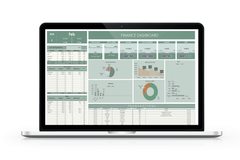You don’t need a dozen accounts or a spreadsheet degree. This guide shows where to park each pound so your cash is safe, earns something, and stays easy to use.
This is also the “where” guide. You’ve set the order and automation—now park each bucket in the right account: easy access hub, regular savers (with realistic maths), fixed bonds (ladder), and when to consider Premium Bonds/ISAs.
New to the order of saving (buffer → sinking funds → goals → pensions/investing)? Read this next (or later): the Savings Waterfall (UK) framework—start there to see the order that actually works.
TL;DR: Quick decision map
-
Need the money in < 3 months?
Keep it 100% Easy Access. -
3–12 months?
Easy Access hub + (optionally) a Regular Saver you drip into monthly. -
1–3 years?
Ladder short fixed bonds (part easy access, part 6–24-month fixes). -
3+ years?
Cash for your buffer/sinking funds; invest long-term goals separately (S&S ISA/pension).
The four cash “jobs” (and the right accounts)
1) Emergency Fund (unexpected stuff)
Best home: High-quality Easy Access saver (FSCS-protected).
Why: Instant access, no penalty, no market risk.
Tip: One account named “Emergency” – don’t mix with spend-from pots.

2) Sinking Funds (planned, irregular costs)
Car, dental, gifts, home maintenance, holidays.
Best home:
- Easy Access “pots/spaces”, or
- Easy Access hub → Regular Saver (you drip in monthly).
Why: You contribute monthly and spend occasionally. Regular Savers can add a bit more interest without daily admin.
Reality check on Regular Savers: the headline (e.g., 7%) applies to a growing balance. A simple rule:
Effective return ≈ headline ÷ 2 on what you pay in over the year. Still worthwhile, just set expectations.
3) Short-Term Goals (≤ 3 years)
House deposit, wedding, course, car.
Best home:
- Start in Easy Access, then
- Ladder 6–24 month fixed bonds for slices you won’t need before maturity.
Why: You lock a portion for a better rate but keep rolling liquidity as rungs mature.
How to ladder (simple):
Split £ into 3 tranches → open three fixed terms (e.g., 6, 12, 18 months). As each matures, either spend (if the goal is due) or roll into a new rung.
If you’re still carrying very high-interest credit-card debt, focus extra cash on debt payoff before aggressive investing. Use the Debt Snowball Calculator to get a timeline and plan.
4) Everyday Buffer (monthly smoothing)
Prevents panic when timing differs (direct debits vs. income).
Best home:
- Easy Access hub called “Hub”.
- Run two standing orders: Current → Hub (payday), Hub → Regular Saver/Sinking pots.
Account types (what they’re good for)
Easy Access (your hub + emergency)
Pros: instant access, simple, pot/space features.
Cons: rate moves more often Use for: Emergency, Hub, Sinking pots you’ll dip into soon.
Regular Savers (drip-feed, usually 12 months)
Pros: higher advertised rate; great for habits.
Cons: monthly caps; “effective” is ~half the headline on total paid in.
Use for: Sinking Funds and “save-up” goals.
Cap vs Excess products:
CAP (“7% up to £3k”): the rate applies to min(balance, cap).
EXCESS (“7% above £5k”): the rate applies only to balance – threshold (never below zero).
They only match at a specific balance (e.g., £8k for 5k threshold + 3k cap); otherwise, slices differ.
Fixed-Rate Bonds (6–24 months)
Pros: usually better rate than easy access.
Cons: no withdrawals without penalty.
Use for: £ you won’t need until the bond matures. Ladder them for rolling access.
Notice Accounts (optional)
Pros: often a middle ground between easy access and fixed.
Cons: you must wait X days to withdraw.
Use for: planned expenses with a known horizon.
Premium Bonds (NS&I)
Pros: capital safe; prizes instead of interest.
Cons: return is a lottery; your personal outcome varies.
Use for: a small “fun” slice, not core emergency funds.
Cash ISA vs. S&S ISA (quick note)
Cash ISA: interest tax-free, often slightly lower headline rate than taxable equivalents. Useful if you’re near Personal Savings Allowance limits.
Stocks & Shares ISA: not cash; use only for 3–5+ year goals. Keep emergency money out of investments.
Picking providers without chasing your tail
Safety first: Look for FSCS protection (up to £85k per banking group).
Access speed: How quickly can you move money back to your current account?
Usability: Pots/spaces, scheduled transfers, clean app.
Rate drift: Avoid micro-optimising. Good enough + automated beats perfect + forgotten.
One-page check-in: Put a monthly reminder to glance at your hub rate; quarterly, decide if a quick move is worth it.
Set-and-forget automation (10 minutes)
Rename accounts: Hub, Emergency, Sinking – Car, Sinking – Travel, House deposit.
Standing orders:
-
Current → Hub on payday (the total you plan to save each month).
Hub → Regular Saver (fixed monthly).
Hub → Sinking pots (splits).
Weekly sweep: If Hub > target, sweep excess to the best rate (or to invest if your long-term step is active).
Rules you’ll actually follow: Save the raise; 24-hour rule on wants; name every pot.
Worked mini-plans (so it clicks)
A) £300/month spare
Buffer (until £1,000): 20% (£60)
Regular Saver: 40% (£120)
Sinking pots: 30% (£90)
Fun: 10% (£30)
B) £2,000 lump sum
Top up buffer to target.
Remainder: 60% 1-year fix, 40% Easy Access (to feed Regular Saver).
C) Irregular income
Pick a base monthly save (e.g., £100).
Add a Friday sweep: anything above £X in current → move to Hub.
Your tools to keep everything on track::
-
Free Savings Distribution Tracker — set Target % for each bucket; it computes £ and charts.
-
One-Tab Monthly Budget & Expense Tracker — one tab- log spending, and see totals. a single dashboard where you set monthly caps (budget), log spending, and see everything at a glance: savings progress, daily cash balance, month-to-date totals, and debt paid. It’s a monthly sheet, but copy it for every month and your totals flow—no setup each time.
-
Best Savings Accounts (UK, Aug 2025) — use this to pick your Hub, Regular Saver, and Fixed Bond.
Behaviour Upgrades (the boring bits that win)
- Save the raise: when income goes up, increase your savings % the same day.
- Name the money: “Emergency”, “Car”, “Travel June” beats “Savings 1/2/3”.
- Friction on spending: 24-hour rule on wants > £50.
- Visible progress: charts = dopamine. Keep them front and centre.
- Fun line is mandatory: a small, explicit fun budget prevents sabotage later.
Still holding double-digit APR debt? After a small buffer + match, prioritise repayment before growing cash piles. Use the Free Debt Snowball Calculator
Common Failure Modes (and the fix)
-
Chasing every headline rate → you never automate.
Fix: pick a top-tier hub + one regular saver; set orders; move on. -
One giant pot called “savings” → accidental spending.
Fix: named pots and the Distribution Tracker. -
No “fun” budget → rebellion later.
Fix: 5–10% fun line, on purpose. -
Ignoring employer benefits → leaving free money on the table.
Fix: read your scheme; set contribution to the max match you can afford. -
Paying 30% APR while hoarding cash → negative spread.
Fix: use the Debt Snowball Calculator; prioritise debt after the micro-buffer.
Your 30-Minute Action Plan (do it now)
- Open the Free Savings Distribution Tracker → enter Amount Available to Save → set target % for Buffer, Sinking, Goal, Fun.
-
-
Create/rename your accounts: Hub, Emergency, Sinking pots, Goal.
Standing orders:
Current → Hub (the total save amount) on payday. Hub → Regular Saver £X/month. Hub → Sinking Funds £Y split across pots.
4. Ask HR: Do you match up to X%? Is it salary sacrifice? Set your pension % accordingly.
5. Open one Fixed-Term Bond (if suitable) for a slice you won’t need for 12 months.
6. Add a weekly sweep: anything above target in Hub → move to best rate (or to invest if you’ve passed Step 6).
7. Track with the One-Tab Monthly Budget & Expense Tracker so you actually see month-end totals and stop guessing.
FAQs
-
Should I invest before a full emergency fund?
Generally no. Build the buffer first so you don’t sell investments in a downturn to fix a boiler. -
Is a 7% regular saver “better” than a 5% fixed bond?
For steady contributions, a 7% regular saver’s effective return on your total yearly deposits is closer to ~3.5–4%. A 5% fixed bond on a lump sum is a true 5% on the full amount. Use both: bond for lump sums, regular saver for monthly cashflow. -
How big should my emergency fund be?
3–6 months of essentials. Err higher if income is variable. Start with £500–£1,000 so you’re protected quickly. -
What if I’m self-employed?
Go heavier on cash buffers (6–12 months), consider pension contributions for tax relief, and automate transfers the day your invoices land.
Final word
You don’t need a complicated plan. You need the right order and automation so it happens even on busy weeks. Do the waterfall in order, name the pots, and let standing orders run your plan.
Plan & split: Free Savings Distribution Tracker
Control the month: One-Tab Monthly Budget & Expense Tracker
Pick accounts: Best Savings Accounts (UK, Aug 2025)
Debt Calculator Snowball method
MVS (today): set two standing orders (Hub + Sinking). Then message HR about matching. Done.





